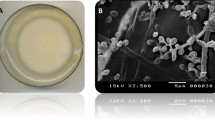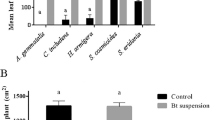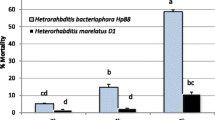Abstract
The pathogen's effectiveness may be influenced by the insect's host plants. The purpose of this study was to examine if the entomopathogenic bacteria Bacillus thuringiensis var. kurstaki (BtK) was compatible with three hosts from diverse plant families including corn (Zea mays L.), lettuce (Lactuca sativa L.) and sugar beet (Beta vulgaris L.) against Spodoptera littoralis (Boisduval). BtK showed highest toxicity toward the sugar beet population compared with other host populations. The LC50 values of BtK were 17.67- and 7.89-fold for corn and sugar beet populations, respectively, lower than those of lettuce population. Because the difference might be explained by the dietary effects of host plants on the overall physiological condition of S. littoralis larvae, the digestive enzymatic and intermediate metabolism were investigated. The α-amylase and lipase activities in the midgut of S. littoralis lettuce population were all significantly higher than those of corn and sugar beet populations, while the highest activity of protease was observed in the corn population. In the lettuce population, the intermediary metabolism response, expressed as acid and alkaline phosphatases (ACP and ALP), was significantly (P ≤ 0.05) lower than those of the sugar beet and corn populations. On the contrary, the activity of lactate dehydrogenase (LDH) significantly increased on lettuce population compared with other host plants. The highest amount of protein (0.188 mg) and triglyceride (TAG: 0.219 mg/mL) was found in larvae fed on lettuce. According to these findings, the host plant has an indirect role in BtK's suppression of cotton leafworm.
Similar content being viewed by others
Abbreviations
- BtK:
-
Bacillus thuringiensis Var. kurstaki
- ACP and ALP:
-
Acid and alkaline phosphatases
- LDH:
-
Lactate dehydrogenase
- TAG:
-
Triglyceride
References
Abbott WS (1925) A method for computing the effectiveness of an insecticide. J Econ Entomol 18:265–267
Bernfeld P (1955) α-Amylases. Methods Enzymol 1:149–151
Bessey OA, Lowry OH, Brock MJ (1946) A method for the rapid determination of alkaline phosphatase with five cubic millimeters of serum. J Biol Chem 164:321–329
Bradford MM (1976) A rapid and sensitive method for the quantitation of microgram quantities of protein utilizing the principle of protein dye binding. Anal Biochem 72:248–254. https://doi.org/10.1016/0003-2697(76)90527-3
Bravo A, Gill SS, Soberon M (2007) Mode of action of Bacillus thuringiensis Cry and Cyt toxins and their potential for insect control. Toxicon 49:423–435
Broderick NA, Goodman RM, Handelsman J, Raffa KF (2003) Effect of host diet and insect source on synergy of gypsy moth (Lepidoptera: Lymantriidae) mortality to Bacillus thuringiensis subsp. kurstaki by Zwittermicin A. Environ Entomol 32(2):387–391. https://doi.org/10.1603/0046-225X-32.2.387
Dicke M, van Poecke RMP, de Boer JG (2003) Inducible indirect defence of plants: from mechanism to ecological function. Basic Appl Ecol 4:27–42. https://doi.org/10.1078/1439-1791-00131
Finney DJ (1971) Probit analysis, 3rd edn. Cambridge University Press, London, p 333
Fossati P, Pencipe L (1982) Serum triglycerides determined colorimetrically with an enzyme that produces hydrogen peroxide. Clinical Chem 28:2077–2080
García-Carreño FL, Haard N (1993) Characterization of protease classes in langostilla Pleuroncodes planipes and crayfish Pacifastacus astacus extracts. J Food Biochem 17:97–113
Hilliou F, Chertemps T, Maïbèche M, Goff GL (2021) Resistance in the genus Spodoptera: key insect detoxification genes. Insects 12(6):544. https://doi.org/10.3390/insects12060544
Huang J, McAuslane HJ, Gregg S, Nuessly GS (2003) Effect of leaf surface extraction on palatability of romaine lettuce to Diabrotica balteata. Entomol Experimentalis et Applicata 106(3):227–234. https://doi.org/10.1046/j.1570-7458.2003.00028.x
Ismail SM (2020) Influences of different host plants on biological and food utilization of the cotton leafworm Spodoptera littoralis. Prog Chem Biochem Res 3(3):229–238. https://doi.org/10.33945/SAMI/PCBR.2020.3.5
Ismail SM, Abdel-Galil FA, Hafez SSh, AbuEl-Ghiet UM (2020) Influence of some insecticides on the incidence of common Lepidopterous insect-pests in field cotton. Egypt Acad J Biol Sci 12(1):23–30. https://doi.org/10.21608/eajbsf.2020.73377
King J (1965) The dehydrogenases or oxidoreductases Lactate dehydrogenase. In: Van Nostrand D (ed) Practical clinical enzymology. Van Nostrand Company Ltd, London, pp 83–93
Kouassi KC, Lorenzetti F, Guertin C, Cabana J, Mauffette Y (2001) Variation in the susceptibility of the forest tent caterpillar (Lepidoptera: Lasiocampidae) to Bacillus thuringiensis variety kurstaki HD-1: Effect of the host plant. J Econ Entomol 94(5):1135–1141. https://doi.org/10.1603/0022-0493-94.5.1135
Kushner DJ, Harvey ET (1962) Antibiotical substances in leaves. Their possible role in insect resistance to diseases. J Insect Pathol 4:155–184
Lacey LA, Frutos R, Kaya HK, Vail P (2001) Insect pathogens as biological control agents: Do they have a future? Biol Control 21:230–248. https://doi.org/10.1006/bcon.2001.0938
Lazarevic J, Peric-Mataruga V, Vlahovic M, Mrdakovic M (2004) Effects of earing density on larval growth and activity of digestive enzymes in Lymantria dispar L. (Lepidoptera: Lymantriidae). Folia Biol 52:1–2
Namin FR, Naseri B, Razmjou J (2014) Nutritional performance and activity of some digestive enzymes of the cotton bollworm, Helicoverpa armigera, in response to seven tested bean cultivars. J Insect Sci 14:93. https://doi.org/10.1093/jis/14.1.93
Naseri B, Fathipour Y, Moharramipour S, Hosseininaveh V, Gatehouse AMR (2010) Digestive proteolytic and amylolytic activities of Helicoverpa armigera in response to feeding on different soybean cultivars. Pest Manag Sci 66:1316–1323
Raymond B, Johnston PR, Nielsen-LeRoux C, Lereclus D, Crickmore N (2010) Bacillus thuringiensis: an impotent pathogen? Trends Microbiol 18:189–194
Roh JY, Choi JY, Li MS, Jin BR, Je YH (2007) Bacillus thuringiensis as a specific, safe, and effective tool for insect pest control. J Microbiol Biotechnol 17(4):547–559
Salama HS, Foda S, Sharaby A (1985) Role of feeding stimuland in increasing the efficacy of Bacillus thuringiensis vs. Spodoptera littoralis (Lepidoptera, Noctuidae). Entomol Generalis 10:111–119
Shikano I (2017) Evolutionary ecology of multitrophic interactions between plants, insect herbivores and entomopathogens. J Chem Ecol 43:586–598. https://doi.org/10.1007/s10886-017-0850-z
Sparks TC, Storer N, Porter A, Slater R, Nauen R (2021) Insecticide resistance management and industry: the origins and evolution of the Insecticide Resistance Action Committee (IRAC) and the mode of action classification scheme. Pest Manag Sci 77(6):2609–2619. https://doi.org/10.1002/ps.6254
Tsujita T, Ninomiya H, Okuda H (1989) P-nitrophenyl 865. butyrate hydrolyzing activity of hormone–sensitive lipase 866 from bovine adipose tissue. J Lipid Res 30:997–1004
Zibaee A, Zibaee I, Sendi JJ (2011) A juvenile hormone analog, pyriproxifen, affects some biochemical components in the hemolymph and fat bodies of Eurygaster integriceps Puton (Hemiptera: Scutelleridae). Pestic Biochem Physiol 100(3):289–298
Funding
No funds, grants, or other support was received.
Author information
Authors and Affiliations
Contributions
SMI subject selection, study design, carried out the experiments, paper writing, collecting, interpretation of the data, and performing statistical analysis. FMAS helped in statistical and chemical analysis. The authors read and approved the final manuscript.
Corresponding author
Ethics declarations
Conflict of interest
The authors declare that they have no competing interests.
Additional information
Publisher's Note
Springer Nature remains neutral with regard to jurisdictional claims in published maps and institutional affiliations.
Rights and permissions
Springer Nature or its licensor holds exclusive rights to this article under a publishing agreement with the author(s) or other rightsholder(s); author self-archiving of the accepted manuscript version of this article is solely governed by the terms of such publishing agreement and applicable law.
About this article
Cite this article
Ismail, S.M., Sleem, F.M.A. Induced Effects of Host Plants on Susceptibility of Cotton Leafworm, Spodoptera littoralis to the Pathogenic Bacterium Bacillus thuringiensis subsp. Kurstaki and on Digestive Enzymatic Activities. Agric Res 12, 172–178 (2023). https://doi.org/10.1007/s40003-022-00633-8
Received:
Accepted:
Published:
Issue Date:
DOI: https://doi.org/10.1007/s40003-022-00633-8




